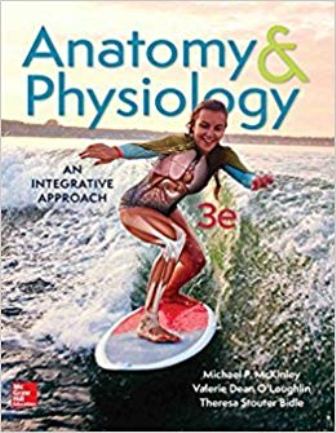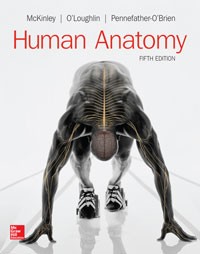Test Bank for Anatomy and Physiology: An Integrative Approach 3rd Edition, by McKinley Dr., Michael, Valerie O’Loughlin, Theresa Bidle
$35.00 Original price was: $35.00.$26.50Current price is: $26.50.
Test Bank for Anatomy and Physiology: An Integrative Approach 3rd Edition, by McKinley Dr., Michael, Valerie O’Loughlin, Theresa Bidle,
Test Bank for Anatomy and Physiology: An Integrative Approach 3rd Edition, by McKinley Dr., Michael, Valerie O’Loughlin, Theresa Bidle

Product details:
- ISBN-10 : 1259398625
- ISBN-13 : 978-1259398629
- Author: Theresa Stouter Bidle, Michael P. McKinley
McKinley/O’Loughlin/Bidle’s Anatomy and Physiology: An Integrative Approach 3e brings multiple elements of the study of A&P together in unique ways that maximize understanding. Covering anatomy and physiology in each chapter, the text emphasizes the interdependence of body systems by weaving prior coverage of one system into textual explanations of how other systems work. All figures are carefully designed to support the text narrative, and they carry brief textual explanations to make figures self-contained study tools. The text helps students apply chapter content by using clinical examples that show students what can go wrong in the body, crystalizing their understanding of the “norm.” Mini self-tests at the end of each section assess students’ grasp of the material, and end-of-chapter assessments encourage students to apply and synthesize what they have learned. Career opportunities for A&P students are highlighted at the beginning of each chapter. Practical advice for remembering material is included throughout, and chapters end with a summary of available media tools.
Table contents:
- Part 1: Organization of the Human Body
- Chapter 1: The Sciences of Anatomy and Physiology
- 1.1 Anatomy and Physiology Compared
- 1.1a Anatomy: Details of Structure and Form
- 1.1b Physiology: Details of Function
- 1.2 Anatomy and Physiology Integrated
- 1.3 How to Study Anatomy and Physiology Effectively
- INTEGRATE: CONCEPT OVERVIEW: Comparing How Anatomists and Physiologists Examine the Human Body
- 1.4 The Body’s Levels of Organization
- 1.4a Characteristics That Describe Living Things
- 1.4b The View from Simplest to Most Complex
- 1.4c Introduction to Organ Systems
- 1.5 The Precise Language of Anatomy and Physiology
- 1.5a Anatomic Position
- 1.5b Sections and Planes
- 1.5c Anatomic Directions
- 1.5d Regional Anatomy
- 1.5e Body Cavities and Membranes
- 1.5f Abdominopelvic Regions and Quadrants
- 1.6 Homeostasis: Keeping Internal Conditions Stable
- 1.6a Components of Homeostatic Systems
- 1.6b Homeostatic Systems Regulated by Negative Feedback
- INTEGRATE: CONCEPT OVERVIEW: Negative Feedback Mechanisms for Regulating Body Temperature
- 1.6c Homeostatic Systems Regulated by Positive Feedback
- 1.7 Homeostasis, Health, and Disease
- Chapter 2: Atoms, Ions, and Molecules
- 2.1 Atomic Structure
- 2.1a Matter, Atoms, Elements, and the Periodic Table
- 2.1b Isotopes
- 2.1c Chemical Stability and the Octet Rule
- 2.2 Ions and Ionic Compounds
- 2.2a Ions
- 2.2b Ionic Bonds
- 2.3 Covalent Bonding, Molecules, and Molecular Compounds
- 2.3a Chemical Formulas: Molecular and Structural
- 2.3b Covalent Bonds
- 2.3c Nonpolar, Polar, and Amphipathic Molecules
- 2.3d Intermolecular Attractions
- 2.4 Molecular Structure and Properties of Water
- 2.4a Molecular Structure of Water
- 2.4b Properties of Water
- 2.4c Water as the Universal Solvent
- 2.5 Acidic and Basic Solutions, pH, and Buffers
- 2.5a Water: A Neutral Solvent
- INTEGRATE: CONCEPT OVERVIEW: Water’s Roles in the Body
- 2.5b Acids and Bases
- 2.5c pH, Neutralization, and the Action of Buffers
- 2.6 Water Mixtures
- 2.6a Categories of Water Mixtures
- 2.6b Expressions of Solution Concentration
- 2.7 Biological Macromolecules
- 2.7a General Characteristics
- 2.7b Lipids
- 2.7c Carbohydrates
- 2.7d Nucleic Acids
- 2.7e Proteins
- INTEGRATE: CONCEPT OVERVIEW: Biological Macromolecules
- 2.8 Protein Structure
- 2.8a Categories of Amino Acids
- 2.8b Amino Acid Sequence and Protein Conformation
- Chapter 3: Energy, Chemical Reactions, and Cellular Respiration
- 3.1 Energy
- 3.1a Classes of Energy
- 3.1b Forms of Energy
- 3.1c Laws of Thermodynamics
- INTEGRATE: CONCEPT OVERVIEW: Energy as It Relates to Human Body Function
- 3.2 Chemical Reactions
- 3.2a Chemical Equations
- 3.2b Classification of Chemical Reactions
- 3.2c Reaction Rates and Activation Energy
- 3.3 Enzymes
- 3.3a Function of Enzymes
- 3.3b Enzyme Structure and Location
- 3.3c Mechanism of Enzyme Action
- 3.3d Classification and Naming of Enzymes
- 3.3e Enzymes and Reaction Rates
- 3.3f Controlling Enzymes
- 3.3g Metabolic Pathways and Multienzyme Complexes
- 3.4 Cellular Respiration
- 3.4a Overview of Glucose Oxidation
- INTEGRATE: CONCEPT OVERVIEW: How Enzymes Work
- 3.4b Glycolysis
- 3.4c Intermediate Stage
- 3.4d Citric Acid Cycle
- 3.4e The Electron Transport System
- 3.4f ATP Production
- 3.4g The Fate of Pyruvate with Insufficient Oxygen
- 3.4h Other Fuel Molecules That Are Oxidized in Cellular Respiration
- Chapter 4: Biology of the Cell
- 4.1 Introduction to Cells
- 4.1a How Cells Are Studied
- 4.1b Cell Size and Shape
- 4.1c Common Features and General Functions
- 4.2 Chemical Structure of the Plasma Membrane
- 4.2a Lipid Components
- 4.2b Membrane Proteins
- 4.3 Membrane Transport
- 4.3a Passive Processes: Diffusion
- 4.3b Passive Processes: Osmosis
- 4.3c Active Processes
- 4.4 Resting Membrane Potential
- 4.4a Introduction
- 4.4b Establishing and Maintaining an RMP
- INTEGRATE: CONCEPT OVERVIEW: Passive and Active Processes of Membrane Transport
- 4.5 Cell Communication
- 4.5a Direct Contact Between Cells
- 4.5b Ligand-Receptor Signaling
- 4.6 Cellular Structures
- 4.6a Membrane-Bound Organelles
- 4.6b Non-Membrane-Bound Organelles
- 4.6c Structures of the Cell’s External Surface
- 4.6d Membrane Junctions
- 4.7 Structure of the Nucleus
- INTEGRATE: CONCEPT OVERVIEW: Cellular Structures and Their Functions
- 4.7a Nuclear Envelope and Nucleolus
- 4.7b DNA, Chromatin, and Chromosomes
- 4.8 Function of the Nucleus and Ribosomes
- 4.8a Transcription: Synthesizing RNA
- 4.8b Translation: Synthesizing Protein
- 4.8c DNA as the Control Center of a Cell
- 4.9 Cell Division
- 4.9a Cellular Structures
- 4.9b The Cell Cycle
- 4.10 Cell Aging and Death
- Chapter 5: Tissue Organization
- 5.1 Epithelial Tissue: Surfaces, Linings, and Secretory Functions
- 5.1a Characteristics of Epithelial Tissue
- 5.1b Functions of Epithelial Tissue
- 5.1c Classification of Epithelial Tissue
- INTEGRATE: CONCEPT OVERVIEW: The Relationship Between Epithelial Tissue Type and Function
- 5.1d Glands
- 5.2 Connective Tissue: Cells in a Supportive Matrix
- 5.2a Characteristics of Connective Tissue
- 5.2b Functions of Connective Tissue
- 5.2c Embryonic Connective Tissue
- 5.2d Classification of Connective Tissue
- INTEGRATE: CONCEPT OVERVIEW: The Relationship Between Connective Tissue Type and Function
- 5.3 Muscle Tissue: Movement
- 5.4 Nervous Tissue: Information Transfer and Integration
- 5.5 Integration of Tissues in Organs and Body Membranes
- 5.5a Organs
- 5.5b Body Membranes
- 5.6 Tissue Development and Aging
- 5.6a Tissue Development
- 5.6b Tissue Modification
- 5.6c Aging of Tissues
- PART 2: Support and Body Movement
- Chapter 6: Integumentary System
- 6.1 Composition and Functions of the Integument
- 6.1a Epidermis
- 6.1b Dermis
- 6.1c Subcutaneous Layer
- 6.1d Functions of the Integument
- INTEGRATE: CONCEPT OVERVIEW: How Integument Form Influences Its Functions
- 6.2 Integumentary Structures Derived from Epidermis
- 6.2a Nails
- 6.2b Hair
- 6.2c Exocrine Glands of the Skin
- 6.3 Repair and Regeneration of the Integumentary System
- 6.4 Development and Aging of the Integumentary System
- 6.4a Development of the Integument and Its Derivatives
- 6.4b Aging of the Integument
- Chapter 7: Skeletal System: Bone Structure and Function
- 7.1 Introduction to the Skeletal System
- 7.2 Bone: The Major Organ of the Skeletal System
- 7.2a General Functions
- 7.2b Classification of Bones
- 7.2c Gross Anatomy of Bones
- 7.2d Bone Marrow
- 7.2e Microscopic Anatomy: Bone Connective Tissue
- 7.2f Microscopic Anatomy: Hyaline Cartilage Connective Tissue
- 7.3 Cartilage Growth
- 7.4 Bone Formation
- 7.4a Intramembranous Ossification
- INTEGRATE: CONCEPT OVERVIEW: The Process of Endochondral Ossification
- 7.4b Endochondral Ossification
- 7.5 Bone Growth and Bone Remodeling
- 7.5a Bone Growth
- 7.5b Bone Remodeling
- 7.5c Hormones That Influence Bone Growth and Bone Remodeling
- 7.6 Regulating Blood Calcium Levels
- 7.6a Activation of Vitamin D to Calcitriol
- 7.6b Parathyroid Hormone and Calcitriol
- 7.6c Calcitonin
- 7.7 Effects of Aging
- 7.8 Bone Fracture and Repair
- Chapter 8: Skeletal System: Axial and Appendicular Skeleton
- 8.1 Components of the Skeleton
- 8.1a Axial and Appendicular Skeleton
- 8.1b Bone Markings
- 8.2 Bones and Features of the Skull
- 8.2a General Anatomy of the Skull
- 8.2b Views of the Skull and Landmark Features
- 8.2c Sutures
- 8.2d Orbital and Nasal Complexes, Paranasal Sinuses
- 8.3 Bones Associated with the Skull
- 8.4 Sex and Age Determination from Analysis of the Skull
- 8.4a Sex Differences in the Skull
- 8.4b Aging of the Skull
- 8.5 Bones of the Vertebral Column
- 8.5a Types of Vertebrae
- 8.5b Spinal Curvatures
- 8.5c Vertebral Anatomy
- 8.6 Bones of the Thoracic Cage
- 8.6a Sternum
- 8.6b Ribs
- 8.7 The Upper and Lower Limbs: A Comparison
- INTEGRATE: CONCEPT OVERVIEW: Similarities Between the Upper Limb and Lower Limb Skeletons
- 8.8 The Pectoral Girdle and Its Functions
- 8.8a Clavicle
- 8.8b Scapula
- 8.9 Bones of the Upper Limb
- 8.9a Humerus
- 8.9b Radius and Ulna
- 8.9c Carpals, Metacarpals, and Phalanges
- 8.10 The Pelvic Girdle and Its Functions
- 8.10a Os Coxae
- 8.10b True and False Pelves
- 8.10c Sex Differences in the Pelvis
- 8.10d Age Differences in the Ossa Coxae
- 8.11 Bones of the Lower Limb
- 8.11a Femur and Patella
- 8.11b Tibia and Fibula
- 8.11c Tarsals, Metatarsals, and Phalanges
- 8.11d Arches of the Foot
- 8.12 Development of the Skeleton
- Chapter 9: Skeletal System: Articulations
- 9.1 Classification of Joints
- INTEGRATE: CONCEPT OVERVIEW: The Relationship Between Mobility and Stability in Joints
- 9.2 Fibrous Joints
- 9.2a Gomphoses
- 9.2b Sutures
- 9.2c Syndesmoses
- 9.3 Cartilaginous Joints
- 9.3a Synchondroses
- 9.3b Symphyses
- 9.4 Synovial Joints
- 9.4a Distinguishing Features and Anatomy of Synovial Joints
- 9.4b Classification of Synovial Joints
- 9.5 The Movements of Synovial Joints
- 9.5a Gliding Motion
- INTEGRATE: CONCEPT OVERVIEW: Synovial Joints
- 9.5b Angular Motion
- 9.5c Rotational Motion
- 9.5d Special Movements
- 9.6 Synovial Joints and Levers
- 9.6a Terminology of Levers
- 9.6b Types of Levers
- 9.7 Features and Anatomy of Selected Joints
- 9.7a Temporomandibular Joint
- 9.7b Shoulder Joint
- 9.7c Elbow Joint
- 9.7d Hip Joint
- 9.7e Knee Joint
- 9.7f Talocrural (Ankle) Joint
- 9.8 Development and Aging of the Joints
People also search:
anatomy and physiology an integrative approach 4th edition quizlet
anatomy and physiology an integrative approach with connect access code
integrated anatomy and physiology
anatomy and physiology an integrative approach 4th edition loose leaf
You may also like…
Solution Manual
Anatomy and Physiology An Integrative Approach 2nd Edition McKinley Solutions Manual
Test Bank
Test Bank for Essentials of Anatomy and Physiology, 8th Edition, Valerie C. Scanlon, Tina Sanders,












